
Manual Transmission Parts Diagram: A Comprehensive Guide
A manual transmission parts diagram is essential for understanding the inner workings of a vehicle’s gearbox․ It illustrates components like gears, bearings, and the clutch, providing a clear visual guide for repairs, maintenance, and rebuilds․ This diagram is vital for identifying parts and their functions, ensuring proper assembly and troubleshooting․ Whether you’re a DIY enthusiast or a professional mechanic, it serves as an invaluable resource for mastering manual transmission systems․
A manual transmission, also known as a stick shift, is a type of gearbox that requires driver input to change gears․ It plays a crucial role in vehicle mechanics, offering control over speed and torque․ Understanding its components, such as gears, bearings, and the clutch, is essential for repairs and maintenance․ A manual transmission parts diagram provides a detailed visual representation of these elements, helping users identify and comprehend their functions․ This guide is designed to break down the complexities of manual transmissions, making it easier for both DIY enthusiasts and professional mechanics to work with them effectively․ It serves as a foundational resource for anyone looking to explore or maintain a manual transmission system․
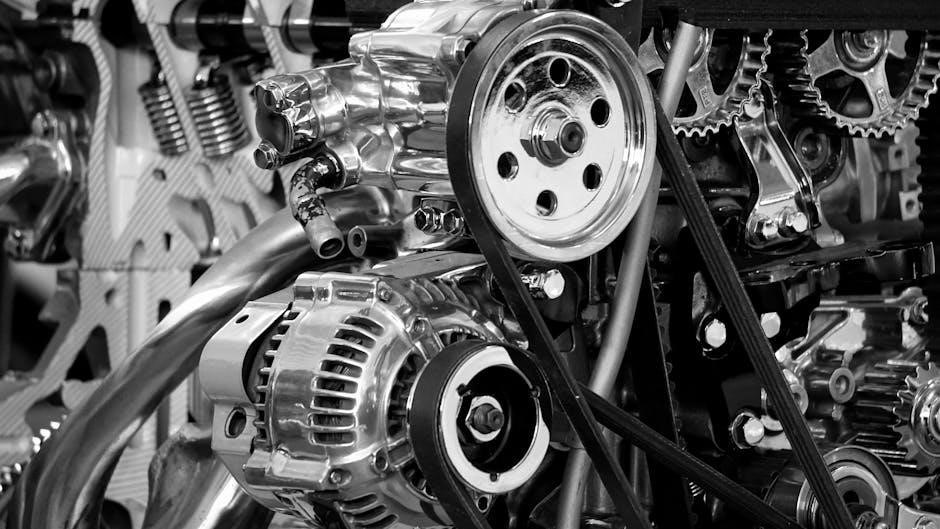
Understanding the Basic Operation of a Manual Transmission
A manual transmission operates by allowing the driver to manually select gears using the clutch pedal and gearshift․ The clutch disconnects the engine from the transmission, enabling smooth gear changes․ The driver presses the clutch, shifts gears, and releases the clutch to engage the selected gear․ This process requires coordination between the clutch, accelerator, and gearshift to ensure smooth acceleration and control․ The manual transmission relies on mechanical components like gears, bearings, and synchronizers to transmit power from the engine to the wheels efficiently․
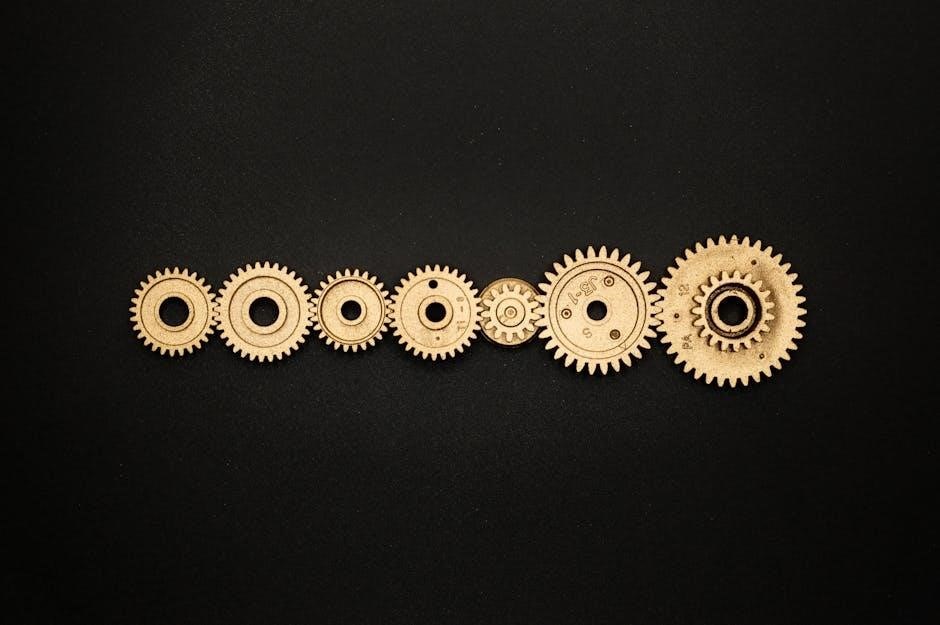
What is a Manual Transmission?
A manual transmission, also known as a stick shift, is a type of gearbox that allows the driver to manually select gears using a clutch pedal and gearshift․ It operates by disconnecting the engine from the transmission when the clutch pedal is pressed, enabling smooth gear changes․ The driver coordinates the clutch, accelerator, and gearshift to control speed and torque․ Unlike automatic transmissions, manual transmissions require active driver involvement, offering better fuel efficiency and driver control․ The manual transmission consists of mechanical components such as gears, bearings, and synchronizers, working together to transmit power from the engine to the wheels efficiently․ This system is widely used in vehicles for its simplicity and effectiveness․
How Does a Manual Transmission Work?
A manual transmission works by allowing the driver to manually switch gears using the clutch pedal and gearshift․ When the clutch pedal is pressed, it disconnects the engine from the transmission, enabling gear changes․ The driver selects the appropriate gear based on speed and load, and the transmission adjusts the torque and speed through its gearset․ The synchronizers ensure smooth gear engagement, while bearings and seals maintain lubrication and prevent wear․ The input and output shafts transfer power from the engine to the wheels, providing control over the vehicle’s movement․ This mechanical process relies on precise coordination between the driver and the transmission components to achieve efficient power delivery․
Why Manual Transmissions Are Important in Vehicle Mechanics
Manual transmissions are crucial in vehicle mechanics due to their simplicity, efficiency, and cost-effectiveness․ They provide drivers with precise control over gear shifts, enhancing fuel efficiency and performance․ Unlike automatic transmissions, manuals have fewer complex components, reducing maintenance and repair costs․ Additionally, they are more reliable in demanding conditions, such as towing or driving uphill, where manual control is advantageous․ Manuals also promote a deeper understanding of vehicle mechanics, making them a preferred choice for driving enthusiasts and technicians alike․ Their longevity and lower failure rates compared to automatics further highlight their importance in automotive engineering and everyday driving applications․

Main Components of a Manual Transmission
The main components include the gearset, clutch assembly, transmission case, input and output shafts, bearings, seals, synchronizers, and gearshift assembly․ These parts work together to enable smooth gear transitions and efficient power transfer from the engine to the wheels, ensuring proper vehicle operation․
The Gearset: Types and Functions
The gearset is a critical component of a manual transmission, consisting of multiple gears that facilitate speed and torque adjustments․ It includes input gears, output gears, and idler gears, each designed for specific ratios to optimize performance․ The gearset operates by engaging and disengaging gears through the synchronizer mechanism, ensuring smooth transitions between speeds․ Different types of gearsets, such as helical and spur gears, offer varying levels of noise reduction and efficiency․ Proper lubrication and alignment are essential to prevent wear and ensure longevity․ Understanding the gearset’s function is key to diagnosing issues and performing effective repairs․
The Clutch Assembly: Purpose and Design
The clutch assembly is a vital component in a manual transmission system, enabling the driver to engage and disengage power from the engine to the gearbox․ Its primary function is to allow smooth transitions between gears without causing damage to the transmission․ The clutch assembly consists of a clutch disc, pressure plate, and release bearing․ When the clutch pedal is pressed, the release bearing disengages the clutch disc from the pressure plate, interrupting power flow․ Upon release, the spring-loaded pressure plate re-engages the disc, reconnecting engine power․ Proper alignment and adjustment of the clutch assembly are crucial for optimal performance and longevity, ensuring efficient gear shifts and preventing wear on transmission components․
The Transmission Case: Housing and Protection
The transmission case is the outer housing that encases all the internal components of the manual transmission, providing structural integrity and protection against environmental factors․ Typically constructed from durable materials such as aluminum or steel, it ensures the longevity of the gearbox by shielding it from contaminants and physical damage․ The case is sealed with gaskets or seals to prevent the loss of transmission fluid, crucial for lubrication and smooth operation․ Its design often includes mounting points for secure installation in the vehicle, minimizing movement and vibrations․ The transmission case plays a vital role in maintaining the overall efficiency and reliability of the transmission system․
The Input and Output Shafts: Roles and Responsibilities
The input and output shafts are critical components within a manual transmission, responsible for transferring power from the engine to the drivetrain․ The input shaft connects directly to the engine’s crankshaft via the clutch, receiving rotational force․ This force is then transmitted through the gearbox to the output shaft, which delivers it to the driveshaft and ultimately the wheels․ Both shafts are precisely engineered to handle varying torque loads and rotational speeds, ensuring smooth power delivery․ Their alignment and integrity are crucial for the transmission’s efficiency, as any damage can lead to mechanical failure and loss of power transmission․

Bearings and Seals: Lubrication and Maintenance
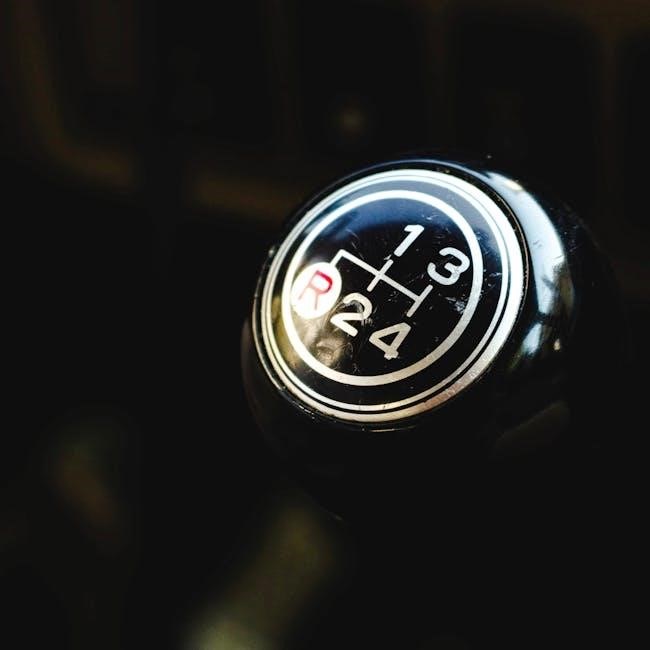
Bearings and seals are essential for ensuring the smooth operation and longevity of a manual transmission․ Bearings reduce friction between moving parts, such as gears and shafts, while seals prevent fluid leaks and contamination․ Proper lubrication is critical, as it prevents overheating and wear on these components․ Transmission fluid must be maintained at the correct level and cleanliness to ensure optimal performance․ Regular inspection of seals for wear or damage is vital, as leaks can lead to fluid loss and system failure․ Bearings should be inspected for smooth rotation and replaced if damaged․ Neglecting these maintenance steps can result in increased wear and potential transmission failure․
Synchronizers and Forks: Ensuring Smooth Gear Shifts
Synchronizers and forks are critical components in a manual transmission, ensuring smooth and precise gear shifts․ Synchronizers function by equalizing the speed of the gear and the shaft, allowing gears to mesh seamlessly․ This prevents grinding and damage during shifting․ The synchronizer hub, sleeve, and teeth work together to achieve this alignment․ Forks, on the other hand, are responsible for engaging and disengaging gears by moving them into or out of mesh․ Proper lubrication of these parts is essential to reduce friction and wear․ Regular maintenance, such as inspecting for worn teeth or misalignment, helps prevent shifting issues and ensures optimal transmission performance․
The Gearshift Assembly: Connecting the Driver to the Transmission
The gearshift assembly is the link between the driver and the transmission, enabling precise control over gear changes․ It consists of the gearshift lever, shift knob, and associated linkage․ The lever connects to the transmission’s internal mechanisms, translating the driver’s movements into gear selections․ The assembly includes components like the shift fork and gear selector, which engage and disengage gears smoothly․ Proper alignment and adjustment of the gearshift assembly are crucial for accurate shifting and preventing wear on internal transmission parts․ Regular lubrication and inspection of these components ensure optimal performance and extend the lifespan of the transmission system․
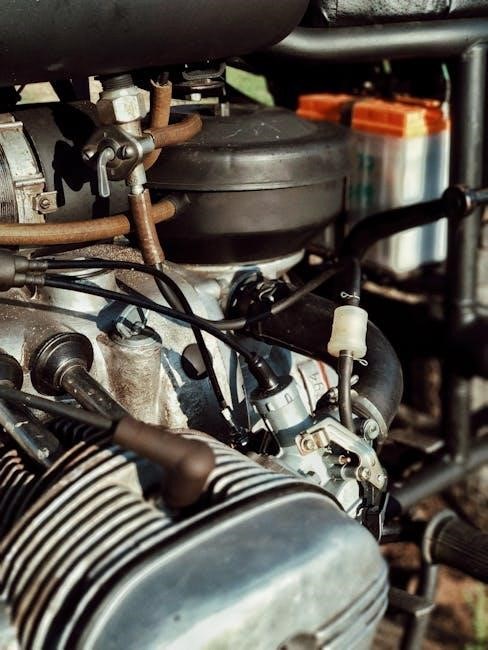
How Manual Transmission Parts Work Together
In a manual transmission, gears mesh to transfer power, while the clutch engages and disengages․ Synchronizers ensure smooth shifting, and bearings reduce friction, enabling efficient power delivery․
The Engagment and Disengagement Process
The Engagement and Disengagement Process
The engagement and disengagement process in a manual transmission involves the clutch and gearsets․ Pressing the clutch pedal disconnects the engine from the transmission, allowing neutral or gear shifts․ Releasing the pedal re-engages the clutch, connecting the engine to the selected gear․ This process is smooth with proper synchronization, essential for avoiding gear grinding and ensuring control․ The clutch’s friction plate engages with the flywheel when the pedal is released, transferring power seamlessly․ This mechanism is critical for efficient shifting and maintaining vehicle performance․ Proper timing and pedal control are key to mastering this process․
Shifting Gears: A Step-by-Step Explanation
Shifting gears in a manual transmission involves coordination between the clutch pedal, gearshift, and accelerator․ Start by fully pressing the clutch pedal to disconnect the engine from the transmission․ Next, move the gearshift into the desired gear, starting with first gear when moving from a standstill․ Ensure the gear is fully engaged by feeling it click into place․ Slowly release the clutch pedal while pressing the accelerator to begin moving․ For higher gears, press the clutch, shift into the next gear, and release smoothly․ Proper timing and balance between the clutch and accelerator ensure a smooth transition․ This process requires practice to master, especially when starting on an incline or switching between gears during acceleration․ Using the clutch and accelerator together prevents rolling backward․ Smooth shifts enhance driving comfort and reduce wear on transmission components․ Regular practice helps develop muscle memory for seamless gear changes․ This skill is essential for safe and efficient driving with a manual transmission․ By following these steps, drivers can maintain control and enjoy the precision of manual driving․ Proper gear shifting also improves fuel efficiency and reduces the risk of mechanical damage․ Over time, the process becomes second nature, allowing drivers to focus on the road and enjoy the driving experience․ Understanding the mechanics behind shifting gears is crucial for troubleshooting issues and performing repairs․ It also highlights the importance of maintaining the clutch and transmission system for optimal performance․ This step-by-step guide provides a clear understanding of how to shift gears effectively, making it easier for new drivers to learn and for experienced drivers to refine their skills․ By mastering this process, drivers can fully utilize the capabilities of their manual transmission vehicle․ The key to successful gear shifting lies in the synchronization of clutch release and accelerator input, ensuring a smooth and controlled transition between gears․ This not only enhances the driving experience but also extends the lifespan of the transmission components․ Learning to shift gears properly is a fundamental skill for anyone driving a manual transmission vehicle, as it directly impacts performance, safety, and fuel efficiency․ With patience and practice, drivers can become proficient in this essential driving technique․ The ability to shift gears smoothly is a hallmark of a skilled driver and is critical for navigating various road conditions effectively․ By adhering to these steps and understanding the underlying mechanics, drivers can optimize their driving experience and maintain their vehicle’s health․ This comprehensive approach to gear shifting ensures that drivers are well-equipped to handle the demands of manual transmission driving․ The process may seem challenging at first, but consistent practice leads to mastery, making every drive more enjoyable and efficient․ The coordination of clutch and accelerator is vital, as it determines the smoothness of gear transitions and the overall performance of the vehicle․ Drivers who take the time to perfect this skill will appreciate the precision and control that manual transmissions offer․ The step-by-step explanation provided here serves as a foundational guide for developing this essential driving skill․ By following these steps and dedicating time to practice, drivers can overcome the initial learning curve and become confident in their ability to shift gears smoothly․ This skill is not only practical but also rewarding, as it allows drivers to fully engage with the driving experience․ Understanding and mastering the gear-shifting process is a key part of owning and maintaining a manual transmission vehicle․ It promotes better control, improves safety, and enhances overall driving satisfaction․ With this knowledge, drivers can tackle various driving scenarios with confidence and precision․ The ability to shift gears effectively is a testament to a driver’s skill and their ability to handle the nuances of manual transmission driving․ By adhering to these steps and practicing regularly, drivers can ensure a seamless and enjoyable driving experience․ The process of shifting gears is a fundamental aspect of driving a manual transmission vehicle, and mastering it is essential for safe and efficient operation․ This guide provides a clear and concise explanation of the steps involved, helping drivers to improve their skills and maintain their vehicles․ The combination of clutch and accelerator control is critical, as it directly impacts the smoothness of gear transitions and the vehicle’s performance․ Drivers who invest time in perfecting this technique will find that it enhances their driving experience and reduces the risk of mechanical issues․ The step-by-step approach outlined here is designed to make learning easier, allowing new drivers to build confidence and competence behind the wheel․ By understanding and applying these principles, drivers can enjoy the benefits of manual transmission driving while minimizing potential challenges․ The key to successful gear shifting lies in the synchronization of clutch release and accelerator input, ensuring a smooth and controlled transition between gears․ This not only enhances the driving experience but also extends the lifespan of the transmission components․ Learning to shift gears properly is a fundamental skill for anyone driving a manual transmission vehicle, as it directly impacts performance, safety, and fuel efficiency․ With patience and practice, drivers can become proficient in this essential driving technique․ The ability to shift gears smoothly is a hallmark of a skilled driver and is critical for navigating various road conditions effectively․ By adhering to these steps and understanding the underlying mechanics, drivers can optimize their driving experience and maintain their vehicle’s health․ This comprehensive approach to gear shifting ensures that drivers are well-equipped to handle the demands of manual transmission driving․ The process may seem challenging at first, but consistent practice leads to mastery, making every drive more enjoyable and efficient․ The coordination of clutch and accelerator is vital, as it determines the smoothness of gear transitions and the overall performance of the vehicle․ Drivers who take the time to perfect this skill will appreciate the precision and control that manual transmissions offer․ The step-by-step explanation provided here serves as a foundational guide for developing this essential driving skill․ By following these steps and dedicating time to practice, drivers can overcome the initial learning curve and become confident in their ability to shift gears smoothly․ This skill is not only practical but also rewarding, as it allows drivers to fully engage with the driving experience․ Understanding and mastering the gear-shifting process is a key part of owning and maintaining a manual transmission vehicle․ It promotes better control, improves safety, and enhances overall driving satisfaction․ With this knowledge, drivers can tackle various driving scenarios with confidence and precision․ The ability to shift gears effectively is a testament to a driver’s skill and their ability to handle the nuances of manual transmission driving․ By adhering to these steps and practicing regularly, drivers can ensure a seamless and enjoyable driving experience․ The process of shifting gears is a fundamental aspect of driving a manual transmission vehicle, and mastering it is essential for safe and efficient operation․ This guide provides a clear and concise explanation of the steps involved, helping drivers to improve their skills and maintain their vehicles; The combination of clutch and accelerator control is critical, as it directly impacts the smoothness of gear transitions and the vehicle’s performance․ Drivers who invest time in perfecting this technique will find that it enhances their driving experience and reduces the risk of mechanical issues․ The step-by-step approach outlined here is designed to make learning easier, allowing
The Role of Hydraulic or Cable-Operated Systems
In manual transmissions, hydraulic or cable-operated systems play a crucial role in connecting the driver’s inputs to the transmission․ These systems operate the clutch and gearshift, enabling smooth engagement and disengagement of gears․ Hydraulic systems use fluid pressure to transmit force, offering precise control and reduced effort, while cable-operated systems rely on mechanical links․ Both ensure the clutch pedal and gearshift function in harmony, allowing drivers to shift gears seamlessly․ These systems are integral to the transmission’s operation, ensuring proper synchronization and minimizing wear on components․ Regular maintenance, such as fluid checks for hydraulic systems or cable adjustments, is essential to maintain optimal performance and prevent mechanical failures․ They are vital for the smooth operation of a manual transmission, enabling drivers to control the vehicle effectively․ Proper functioning of these systems is critical for both performance and safety, making them a key focus in transmission maintenance and repairs․ Understanding their role helps drivers appreciate the engineering behind manual transmissions and the importance of proper upkeep․ These systems are a cornerstone of manual transmission functionality, ensuring precise control and reliability․ By maintaining them, drivers can enjoy a smooth and responsive driving experience․ The hydraulic or cable-operated systems are essential for translating driver input into precise mechanical actions, making them indispensable in the operation of manual transmissions․ Their reliability directly impacts the overall driving experience, highlighting the need for regular checks and maintenance․ This ensures that the transmission operates as intended, providing years of trouble-free service․ The role of these systems is fundamental to the functionality of manual transmissions, making them a critical area of focus for both drivers and mechanics․ Their proper operation ensures that gear shifts are smooth and precise, reducing wear on the transmission and enhancing driving satisfaction․ By understanding how these systems work, drivers can better appreciate the complexity and precision of manual transmissions․ Regular maintenance of hydraulic or cable-operated systems is essential to prevent issues like clutch slippage or difficulty shifting gears․ These systems are the link between the driver and the transmission, enabling precise control over gear changes․ Their importance cannot be overstated, as they directly impact the vehicle’s performance and responsiveness․ Ensuring they function correctly is vital for maintaining the health of the transmission and the overall driving experience․ The hydraulic or cable-operated systems are a key component in the operation of manual transmissions, providing the necessary connection between the driver’s inputs and the transmission’s mechanical actions․ They are essential for smooth gear shifts and proper clutch engagement, making them a critical part of the vehicle’s drivetrain․ By maintaining these systems, drivers can ensure their manual transmission operates efficiently and reliably․ The role of hydraulic or cable-operated systems is vital for the optimal performance of a manual transmission, emphasizing the need for regular maintenance and care․ These systems are the backbone of manual transmission functionality, ensuring that every gear shift is precise and controlled․ Their importance is evident in the smooth operation of the vehicle, making them a key focus for drivers and mechanics alike․ Properly functioning hydraulic or cable-operated systems are essential for enjoying the benefits of a manual transmission, including better control and fuel efficiency․ They are a testament to the engineering that goes into creating responsive and reliable drivetrains․ By understanding and maintaining these systems, drivers can extend the life of their transmission and enjoy a more engaging driving experience․ The hydraulic or cable-operated systems are a fundamental part of manual transmissions, enabling drivers to shift gears smoothly and maintain control over the vehicle․ Their proper operation is crucial for both performance and safety, making them a priority in transmission maintenance․ These systems exemplify the precision and complexity of manual transmissions, highlighting the need for regular upkeep to ensure they function as intended․ By caring for these systems, drivers can preserve the integrity of their transmission and continue to enjoy the unique advantages of manual driving․ The role of hydraulic or cable-operated systems in manual transmissions cannot be overlooked, as they are the link between the driver and the gears․ Their smooth operation ensures that every shift is precise and effortless, enhancing the overall driving experience․ Regular maintenance of these systems is essential to prevent issues and maintain the transmission’s performance․ They are a critical component in the operation of manual transmissions, demonstrating the importance of proper care and attention․ By maintaining hydraulic or cable-operated systems, drivers can ensure their manual transmission continues to function smoothly and efficiently, providing years of reliable service․ The hydraulic or cable-operated systems are essential for the smooth operation of manual transmissions, enabling drivers to shift gears with precision and control․ Their proper functioning is vital for the overall performance of the vehicle, making them a key area of focus for maintenance and repairs․ By understanding how these systems work and ensuring they are well-maintained, drivers can enjoy a seamless and responsive driving experience․ The role of hydraulic or cable-operated systems is fundamental to the operation of manual transmissions, emphasizing the need for regular checks and maintenance․ They are the unsung heroes of the manual transmission, working behind the scenes to enable smooth gear shifts and precise control․ Proper care of these systems is essential to maintain the health and performance of the transmission, ensuring that every drive is enjoyable and efficient․ The hydraulic or cable-operated systems are a critical part of manual transmissions, providing the necessary connection between the driver’s inputs and the transmission’s gears․ Their smooth operation is vital for the vehicle’s performance and responsiveness, making them a key focus for drivers and mechanics․ By maintaining these systems, drivers can ensure their manual transmission operates efficiently and reliably, providing years of trouble-free service․ The role of hydraulic or cable-operated systems is essential for the optimal operation of manual transmissions, highlighting the importance of regular maintenance and care․ These systems are the backbone of manual transmission functionality, enabling precise control over gear shifts and clutch engagement․ Their proper operation is crucial for both performance and safety, making them a priority in transmission upkeep․ By understanding and maintaining these systems, drivers can enjoy a smooth and responsive driving experience while extending the life of their transmission․ The hydraulic or cable-operated systems are a key component in the operation of manual transmissions, providing the necessary link between the driver and the gears․ Their smooth functioning ensures that every gear shift is precise and controlled, enhancing the overall driving experience․ Regular maintenance of these systems is vital to prevent issues and maintain the transmission’s performance․ They are a critical part of manual transmissions, demonstrating the importance of proper care and attention․ By maintaining hydraulic or cable-operated systems, drivers can ensure their manual transmission continues to function smoothly and efficiently, providing years of reliable service․ The role of hydraulic or cable-operated systems in manual transmissions cannot be overstated, as they are the link between the driver’s inputs and the transmission’s gears․ Their smooth operation ensures that every shift is precise and effortless, enhancing the overall driving experience․ Regular maintenance of these systems is essential to prevent issues and maintain the transmission’s performance․ They are a critical component in the operation of manual transmissions, demonstrating the importance of proper care and attention․ By maintaining hydraulic or cable-operated systems, drivers can ensure their manual transmission continues to function smoothly and efficiently, providing years of reliable service․ The hydraulic or cable-operated systems are essential for the smooth operation of manual transmissions, enabling drivers to shift gears with precision and control․ Their proper functioning is vital for the overall performance of the vehicle, making them a key area of focus for maintenance and repairs․ By understanding how these systems work and ensuring they are well-maintained, drivers can enjoy a seamless and responsive driving experience․ The role of hydraulic or cable-operated systems is fundamental to the operation of manual transmissions, emphasizing the need for regular checks and maintenance․ They are the unsung heroes of the manual transmission, working behind the scenes to enable smooth gear shifts and precise control․ Proper care of these systems is essential to maintain the health and performance of the transmission, ensuring that every drive is enjoyable and efficient․ The hydraulic or cable-operated systems are a critical part of manual transmissions, providing the necessary connection between the driver’s inputs and the transmission’s gears․ Their smooth operation is vital for the vehicle’s performance and responsiveness, making them a key focus for drivers and mechanics․ By maintaining these systems, drivers can ensure their manual transmission operates efficiently and reliably, providing years of trouble-free service․ The role of hydraulic or cable-operated systems is essential for the optimal operation of manual transmissions, highlighting the importance of regular maintenance and care․ These systems are the backbone of manual transmission functionality, enabling precise control over gear shifts and clutch engagement․ Their proper operation is crucial for both performance

Reading and Interpreting a Manual Transmission Parts Diagram
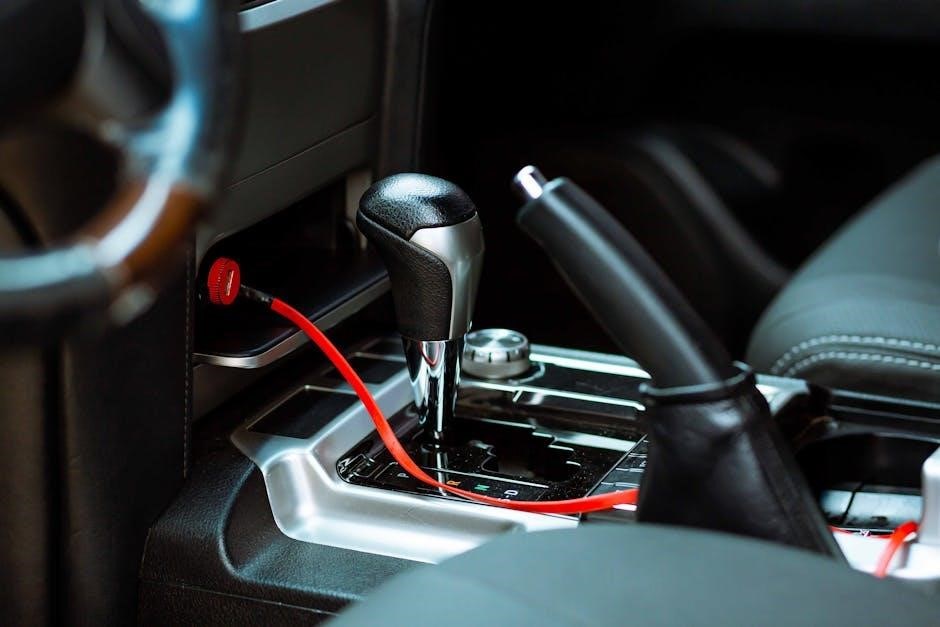
A manual transmission parts diagram is a detailed visual guide that illustrates the components and their relationships․ It helps identify gears, bearings, and other parts, making repairs easier․ By understanding the symbols and layout, you can locate and replace components efficiently․ This diagram is essential for DIY enthusiasts and professionals alike, ensuring accurate disassembly and reassembly of the transmission․ It serves as a roadmap for maintenance and troubleshooting, helping you understand how each part functions within the system․
Understanding the Symbols and Notations
Manual transmission parts diagrams use specific symbols and notations to represent components and their relationships․ Gears are often shown as toothed circles, while bearings may appear as rings or shaded areas․ Arrows indicate flow directions, such as power transfer from the input to output shafts․ Color coding or shading can differentiate moving parts or highlight critical components․ Lines and dots may signify connections or mounting points․ Symbols for seals, gaskets, and fasteners are also common․ A legend or key is usually provided to decode these symbols, ensuring accurate interpretation․ Understanding these notations is crucial for identifying parts, diagnosing issues, and performing repairs effectively․
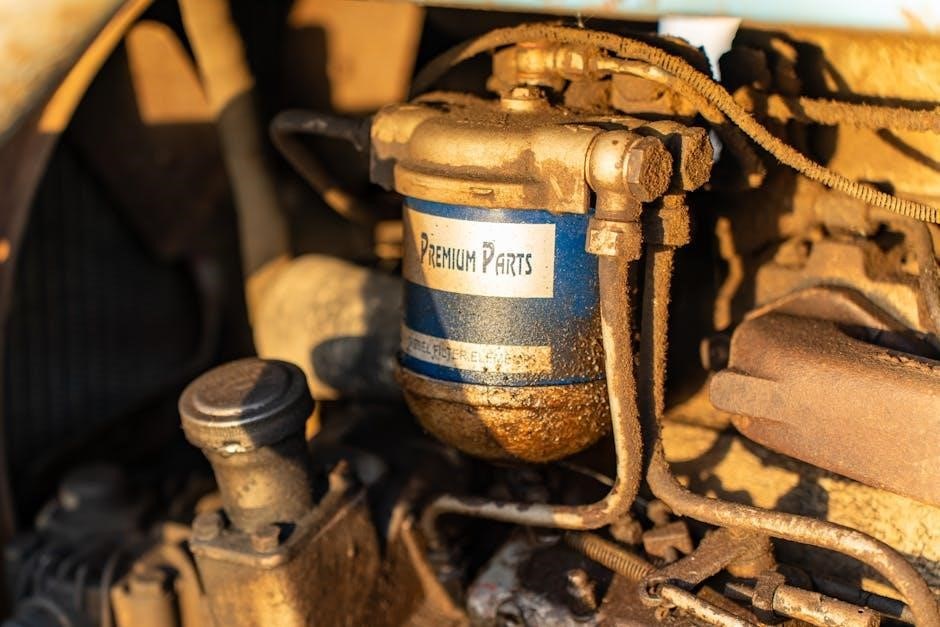
and Final Thoughts
Identifying Each Component in the Diagram
A manual transmission parts diagram provides a detailed visual representation of the gearbox, allowing users to identify each component accurately․ Key elements like gears, shafts, bearings, and synchronizers are typically labeled with numbers or letters․ Colors or shading may differentiate moving parts or highlight critical components․ The diagram often includes a key or legend to explain symbols, ensuring clarity․ By examining the layout, one can trace power flow from the input shaft to the output shaft, observe gear ratios, and understand how components interact․ This visual guide is indispensable for diagnosing issues, planning repairs, and ensuring proper reassembly․ Familiarity with the diagram enhances mechanical understanding and repair efficiency․